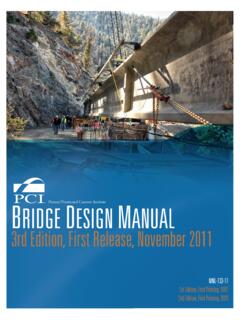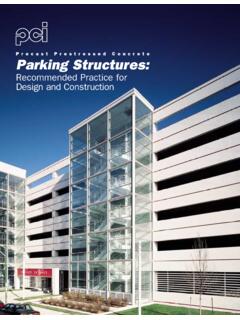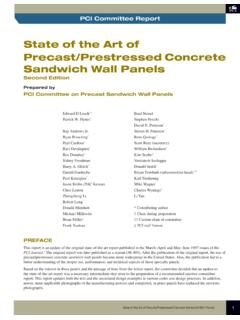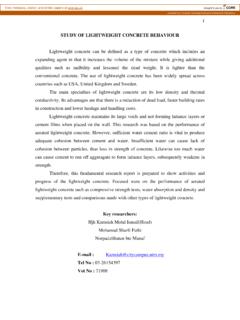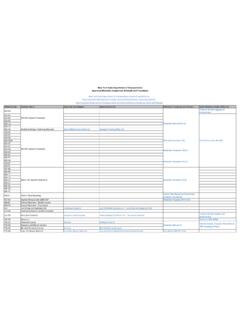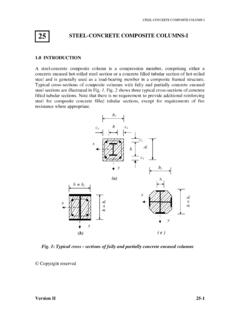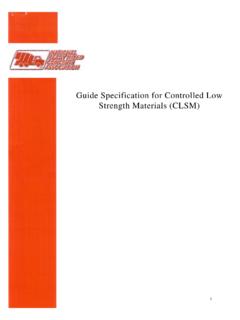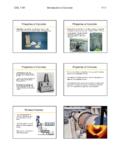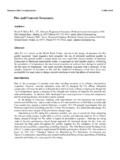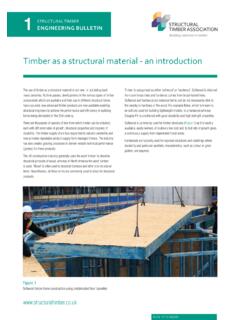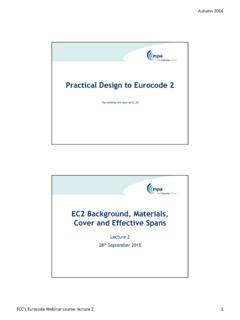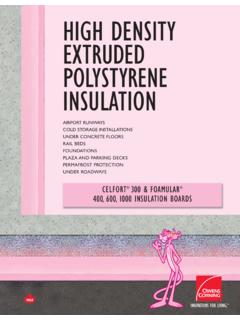Transcription of Recommended Practice for Design, Manufacture, and ...
1 Recommended Practice for Design, Manufacture, and Installation of Prestressed concrete Piling PCI Prestressed concrete Piling Section 1 Introduction Committee Prestressed concrete piles are vital elements in the founda- JP Binard, PE, chair tions of buildings, bridges and marine structures throughout Sriram Aaleti, PhD the world. They usually vary in size from 12 in. (305 mm). Simon Harton, PE square piles used in building foundations to 66 in. (1680. Louis Klusmeyer, PE, SE mm) diameter cylindrical piles used in marine structures Andrew Levens, PE and bridges. Many areas of North America have poor soil Richard Potts, PE conditions requiring pile foundations for even relatively light Mehedi Rashid, PE, SE structures. In such areas, prestressed concrete piling has Sami Rizkalla, PhD come to be the usual method of construction, with prestressed Joe Rose, PE concrete having been proved the logical choice of materials Stephen Seguirant, PE where permanence, durability, and economy must be con- Sri Sritharan, PhD sidered.
2 Heavy marine structures often rely on prestressed Catrina Walter, PE concrete piles driven through deep water or through deep Christopher White, PE layers of unsuitable material for their support. Prestressed Danny Wong concrete piles can be designed to safely support these heavy axial loads, as well as lateral loads caused by wind, waves, Consulting Members and earthquakes. In marine environments, these piles can re- sist corrosion caused by salt water and by thousands of cycles John Dick of wetting and drying. Roy Eriksson, PE. Mohamad Hussein, PE Scope of report John Kelly, PE. Jan Landreth-Smith This report contains recommendations and guidelines for Farshad Mazloom the design and detailing of prestressed concrete piles based Mac McCalla, PE on current knowledge and standards. It updates the pre- Saad Eldin Moustafa, PhD vious version of the report published in the March April John Ryan, PhD, PE 1993 issue of the PCI Although typical pile cross sections discussed in this report are those most commonly Staff Liaison found throughout the United States and Canada, the intent of this report is not to limit the geometric configuration or William N.
3 Nickas, PE material properties of prestressed concrete piling. For the first time in a PCI publication on prestressed pile design, perfor- Technical Editor mance-based design is presented. Performance-based design of prestressed concrete piles allows the designer to detail Timothy Mays, PhD, PE prestressed concrete piles more economically than prescrip- tive methods typically allow, with nontraditional materials or material properties or novel construction techniques, as long as the expected performance meets the requirements of this report and those contained in the governing code for the structure. Local prestressed concrete manufacturers should be consulted for readily available cross sections. Design tables and details presented are intended to aid the qualified design- 84 PCI Journal | July August 2019. er. Actual design details, including the selection of materials, ASTM A572, Standard Specification for High-Strength pile sizes, and pile shapes, should conform to local practices Low-Alloy Columbium-Vanadium structural Steel and code requirements.
4 ASTM A615, Standard Specification for Deformed and Plain Materials Section 2 discusses cements, aggregates, Carbon-Steel Bars for concrete Reinforcement water, admixtures, and reinforcement. Recommendations are made regarding these constituents and their effects on the qual- ASTM A706, Standard Specification for Deformed and Plain ity and strength of concrete . Low-Alloy Steel Bars for concrete Reinforcement Design Section 3 begins with a discussion of various ASTM A722, Standard Specification for High-Strength Steel factors that should be considered in the design of prestressed Bars for Prestressed concrete concrete piles and pile foundations. Prescriptive and perfor- mance-based design provisions are presented in detail with ASTM A882, Standard Specification for Filled Epoxy-Coated reference to how they should be used in conjunction with Seven-Wire Prestressing Steel Strand governing codes and standards. Although some design aids are provided, reference is made to PCI's free software program ASTM A884, Standard Specification for Epoxy-Coated Steel (PCI PD-01) for developing axial-moment interaction dia- Wire and Welded Wire Reinforcement grams for the ultimate capacity of commonly used pile sizes of varying concrete strengths and effective prestress levels.
5 ASTM A1060, Standard Specification for Zinc-Coated (Galvanized) Steel Welded Wire Reinforcement, Plain and Good design Practice requires clear communication between Deformed, for concrete the project engineer of record, the project geotechnical engi- neer, and, when applicable, the specialty engineer responsible ASTM A1064, Standard Specification for Carbon-Steel Wire for the design of the prestressed concrete piling. and Welded Wire Reinforcement, Plain and Deformed, for concrete Manufacture and transportation Section 4 covers special requirements involved in the manufacture, handling, ASTM C31, Standard Practice for Making and Curing Con- transportation, and tolerances for prestressed concrete piles. crete Test Specimens in the Field Installation The purpose of section 5 is to set forth ASTM C33, Standard Specification for concrete Aggregates general principles for proper prestressed concrete pile instal- lation. Discussion of handling- and driving-induced com- ASTM C39, Standard Test Method for Compressive Strength pression, tension, bending, and torsion provides a basis for of Cylindrical concrete Specimens recommendations to prevent damage to prestressed concrete piles.
6 Techniques related to the cutting or occasional extension ASTM C143, Standard Test Method for Slump of Hydraulic of piles are suggested. Cement concrete Current research and future applications for ASTM C150, Standard Specification for Portland Cement prestressed concrete piling Section 6 concludes this report by highlighting some of the current issues and future ASTM C172, Standard Practice for Sampling Freshly Mixed research needs involving the design, manufacture, and installa- concrete tion of prestressed concrete piles. A state of Practice overview of mitigating and monitoring the effects of pile-driving vibrations ASTM C260, Standard Specification for Air-Entraining is included. Current pile-related research showing great promise Admixtures for concrete is mentioned and future research needs are also examined. ASTM C330, Standard Specification for Lightweight Aggre- Standards and references gates for structural concrete ASTM standards ASTM C494, Standard Specification for Chemical Admixtures for concrete ASTM A29, Standard Specification for General Requirements for Steel Bars, Carbon and Alloy, Hot-Wrought ASTM C595, Standard Specification for Blended Hydraulic Cements ASTM A416, Standard Specification for Low-Relaxation, Seven-Wire Steel Strand for Prestressed concrete ASTM C618, Standard Specification for Coal Fly Ash and Raw or Calcined Natural Pozzolan for Use in concrete ASTM A421, Standard Specification for Stress-Relieved Steel Wire for Prestressed concrete ASTM C989, Standard Specification for Slag Cement for Use PCI Journal | July August 2019 85.
7 In concrete and Mortars PCI MNL-137, Manual for the Evaluation and Repair of Precast, Prestressed concrete Bridge Products ASTM C1107, Standard Specification for Packaged Dry, Hydraulic-Cement Grout (Nonshrink) PCI PD-01, Calculation of Interaction Diagrams for Precast, Prestressed Piles ASTM C1157, Standard Performance Specification for Hy- draulic Cement PCI STD-112, Standard Prestressed concrete Piles ASTM C1240, Standard Specification for Silica Fume Used PCI STD-113, Prestressed concrete Sheetpiles in Cementitious Mixtures American Welding Society (AWS) standards ASTM C1260, Standard Test Method for Potential Alkali Reactivity of Aggregates (Mortar-Bar Method) AWS , structural Welding Code Steel ASTM C1602, Standard Specification for Mixing Water Used AWS , structural Welding Code Reinforcing Steel in the Production of Hydraulic Cement concrete Post-Tensioning Institute (PTI). ASTM C1611, Standard Test Method for Slump Flow of References Self-Consolidating concrete PTI , Specification for Grouting of Post-Tensioned ASTM C1778, Standard Guide for Reducing the Risk of Dele- Structures terious Alkali-Aggregate Reaction in concrete Section 2 Materials ASTM D1143, Standard Test Methods for Deep Foundations Under Static Axial Compressive Load Material properties and requirements for prestressed concrete piles are almost identical to those for all precast, ASTM D3689, Standard Test Methods for Deep Foundations prestressed concrete structural members.
8 Piles, however, are Under Static Axial Tensile Load subject to long-term contact with soil and moisture as well as submergence in water and other aggressive environments. ASTM D3966, Standard Test Methods for Deep Foundations Therefore, the in-service conditions require that materi- Under Lateral Load als used in piles be carefully selected to reduce long-term durability issues such as corrosion, alkali-silica reaction, and ASTM D4945, Standard Test Method for High-Strain Dynam- delayed ettringite formation. Special consideration should ic Testing of Deep Foundations be given to using appropriate materials that ensure satis- factory short- and long-term performance of the piling. On ASTM D7383, Standard Test Methods for Axial Compressive any project, in addition to satisfying the recommendations Force Pulse (Rapid) Testing of Deep Foundations provided in this report, designers must also consider local or state specifications governing the use and availability of American concrete Institute (ACI) standards certain products or materials used to construct prestressed and guides concrete piles.
9 This section provides a detailed discussion regarding material constituents of concrete . Before casting ACI , Guide to Durable concrete prestressed concrete piles, the mixture proportions for the concrete should be submitted to the engineer or owner for ACI 318, Building Code Requirements for structural Con- review and approval. crete and Commentary Cementitious materials ACI 543R, Guide to Design, Manufacture, and Installation of concrete Piles Portland cement conforming to ASTM C150 Types I, II, III, or V is commonly used in prestressed concrete piling. Blend- PCI standards and references ed and performance-based cements conforming to ASTM. C595 and ASTM C1157 may also be used in prestressed con- PCI MNL-116, Manual for Quality Control for Plants and crete piling. Selection of the appropriate cement type and oth- Production of structural Precast concrete Products er constituents for a particular project should be based on the exposure conditions to which the piles will be subjected and PCI MNL-120, PCI Design Handbook: Precast and Pre- local experience in these conditions, in addition to strength, stressed concrete strength gain, and workability requirements.
10 Type III (or high early strength) cement is often used for piles to facilitate rapid PCI MNL-133, PCI Bridge Design Manual reuse of the formwork. 86 PCI Journal | July August 2019. In areas of moderate exposure to sulfate-containing soils higher compressive strengths, their use in piles is primarily to (soils containing to of water-soluble sulfate by increase the long-term durability of concrete . When combined weight) or sulfate-containing waters (seawater or waters con- in the proper proportions, the result is generally a denser, less taining 150 to 1500 ppm dissolved sulfate), the tricalcium alu- porous concrete with greater resistance to chloride and sulfate minate (C3A) content of the cement should be limited to 8% penetration. Many local and state specifications have require- (ACI 318-14).2 Note that seawater is explicitly listed under ments for their use under certain exposure conditions or limit Exposure Class S1 with the acknowledgment that water-sol- their proportions relative to the total cementitious material uble-sulfate concentration may exceed 1500 ppm dissolved content.
